Mistyczna Etiopia
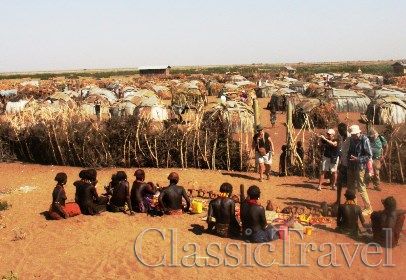
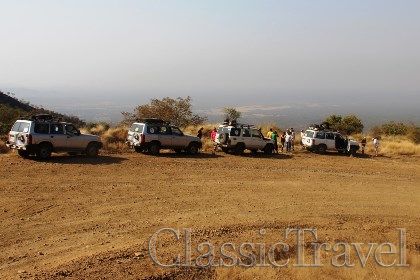
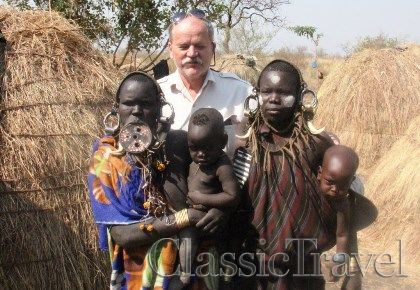
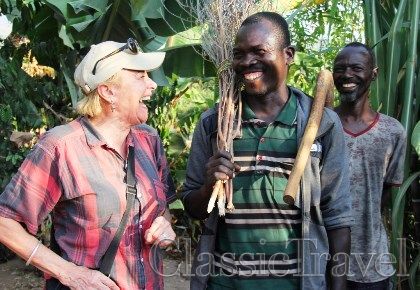
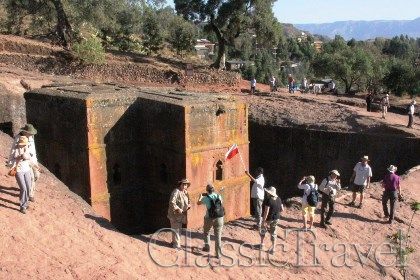

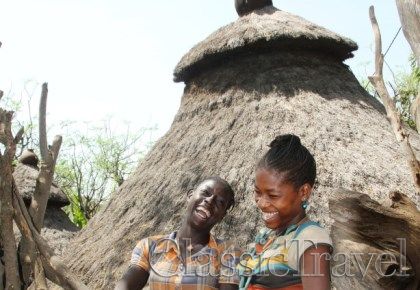
Mistyczna Etiopia
Etiopia to kraj na wskroś Mistyczny, pełny tajemnic z początków chrześcijaństwa w jej północnej części i niezliczonej ilości plemion i grup etnicznych na południu. Przepiękne pejzaże południa a szczególnie Doliny Omo, gdzie dominują plemiona Konso, Hammer, Dassanach i Mursi. Zachwycają i szokują one swoją odmiennością dekoracji ciała i ubioru oraz sposobem życia jak przed kilku wieków p.n.e. Na północy zaś Aksum- serce starożytnej Etiopii, pełne steli i obelisków, budowli z czasów królowej Saby oraz sanktuarium, w którym mieści się oryginalna Arka Przymierza.
W Lalibela zaś dominują monoliczne klasztory i kościoły wykute litej skale. W Gondar – antycznej stolice Etiopii zobaczymy pięć zamków które, przypominają o bogatej historii królów z 15 i 16 wieku. Tutaj też będziemy obserwować a nawet uczestniczyć celebrowaniu Święto TIMKAT, którego najważniejszą częścią jest kolorowa procesja. Ta wycieczka to podróż w czasie, która pozwoli zrozumieć, dlaczego Etiopia była jedynym krajem w Afryce, który nigdy nie był kolonią. Ta turystyczna wyprawa to podróż do dwóch odmiennych światów w granicach jednego kraju! Poznaj i przeżyj to z nami. Zapraszamy.
-
Autor: real cialis no genericData wystawienia: 28 sierpnia 2020
-
Autor: Sylvester Szliowski (Uczestnik wycieczki)Data podróży: January 5-21, 2018Data wystawienia: 19 kwietnia 2018
Dodaj komentarz lub oceń wycieczkę
Day 1. (01/06. Mon.) Wylot z Newarku do Addis Abeby
Wylot z Newarku o 10:00am na non-stop lot do Addis Ababa liniami Ethiopian Airway #509. Śniadanie, kolacja i śniadanie na pokładzie samolotu.
D. 2. (1/07. Tue.) Przylot do Addis Abeby & City Tour.
Przylot o 10:10am (czasu lokalnego) na Bole Int’l Airport. Powitanie przez naszego przewodnika i transfer do 5*hotelu Golden Tulip Addis Ababa. Zameldowanie w hotelu. Po półtorej godzinie relaksu w hotelu rozpoczniemy zwiedzanie miasta – stolicy Etiopii. Odwiedzimy kilka zabytków, w tym Narodowe Muzeum Archeologiczne, aby zobaczyć 3,6-milionowe szczątki „Lucy”, której szkielet odkryto w 1974 roku. Następnie do Muzeum Etnologicznego na Uniwersytecie w Addis Abebie; które oferuje świetny wgląd w wiele różnych ludów Etiopii i ich kultury, zwiedź „Marcato”, największy rynek w Afryce. Nasze zwiedzanie będzie kontynuowane w Katedrze Świętej Trójcy (jeśli renowacja zostanie sfinalizowana), a zakończymy dzień przejazdem na szczyt góry Entoto, która wznosi się na wysokość 10 500 stóp i oferuje panoramiczny widok na metropolię. Powrót do hotelu na kolacje i nocleg. (L, D)
D. 3. (1/08. Wed.) Przelot: Addis Abeba - Jinka
Po śniadaniu transfer na lotnisko na przylot do Jinak -stolicy plemion z doliny Omo. Po zameldowaniu w ekologicznym hotelu, rozpoczniemy zwedzanie okolice Jinka, które są pełne fantastycznych krajobrazów i dzikiej przyrody. Czas płynie tam wolniej i wszystko toczy się swoim afrykańskim rytmem. Po południu zwiedzanie lokalnego muzeum i wizyta w wiosce plemienia Ari. Uprawiają oni kawę, sorgo i egzotyczne dla nas owoce. Nocleg w naszym lodge. (B,L,D)
D. 4. (1/09. Thu.) Jinka - Turmi
Po śniadaniu przejazd do Parku Narodowego Mago, gdzie żyje plemię Mursi. To najbardziej rozpoznawalne plemię ludów zamieszkujących dolinę rzeki Omo. Kiedy kobiety Mursi wkraczają w dorosłość, wycina się im dolną wargę i umieszcza w niej gliniany lub drewniany krążek. Tarcze zastępowane są coraz większymi, te najbardziej efektowne osiągają średnicę do 35 cm. Wielkość krążka i inne ozdoby znajdujące się na całym ciele decydują o atrakcyjności kobiety i jej wartości (narzeczony musi odpowiednio płacić rodzinie za swoją przyszłą żonę). Mężczyźni z tego plemienia dekoracyjnie malują swoje ciała, ich twarze są najczęściej pokryte białymi wzorami. Po lunczu przejazd do miasteczka Key Afer na czwartkowy targ plemienny, uznawany za najciekawszy w południowej Etiopii. Odwiedzają go przedstawiciele plemion Bana i Tsemay. Transfer do Turmi na nocleg w naszej lodge. (B,L,D)
D. 5. (1/10. Fri.) Turmi - Omorate - Karo - Turmi
Po śniadaniu przejazd do Omorate i przeprawa łodzią (ewentualnie dłubankami) przez rzekę Omo, aby odwiedzić wioskę ludu Dassanach. Tutaj wszystkie role w życiu codziennym pełnią kobiety, natomiast rola mężczyzn ogranicza się do ochrony wsi. Po powrocie zjemy lunch do naszej lodge w Turmi. Po krótkim odpoczynku jedziemy dalej do małej wioski Karo Kortcho. Tutejsi ludzie są ekspertami w zdobieniu ciała, które malują na różne sposoby, a mężczyźni rzeźbią i golą włosy w ekstrawaganckie kształty. Po południu, jeśli będziemy mieć szczęście (ze względu na brak możliwości zorganizowania tej ceremonii dla turystów), zobaczymy specjalną ceremonię zwaną Bull Jumping, która wprowadza chłopca w męskość. Najpierw krewni tańczą i zapraszają na chłostę mężczyzn, których niedawno uznano za dorosłych; pokazuje to ich wsparcie dla skoczka, a blizny dają im prawo do żądania jego pomocy w potrzebie. Chłopiec musi co najmniej dwukrotnie przeskakiwać tam i z powrotem przez grzbiety kilku byków lub krów. Kolacja i nocleg w naszym Lodge. (B,L,D)
D. 6. (1/11. Sat.) Turmi – Konso
Po śniadaniu przejazd do miasteczka Dimeka na targ plemienia Hamer. Następnie udamy się w stronę Konso podziwiając krajobraz doliny Omo. Po przyjazdzie do Konso, nocleg w naszej lodge. (B,L,D)
D. 7. (1/12. Sun.) Trasa: Konso - Arba Minch
Rano po śniadaniu wizyta w wiosce Konso będącej na liscie UNESCO. Pogańskie społeczeństwo Konso wznosi nad grobami zmarłych niesamowite drewniane totemy, pełne fallicznych symboli. Mają także liczne kulty oparte na hodowli i czci węży. Jednakże kamieniem węgielnym kultury Konso jest wysoce wyspecjalizowana i odnosząca sukcesy gospodarka rolna, która dzięki tarasom wzmocnionym kamieniem umożliwia tym ludziom produktywne życie z otaczających ich niezbyt żyznych wzgórz i dolin. Będzie to doskonały dzień na spotkanie się z tymi ludźmi, zrobienie z nimi zdjęć i poznanie z pierwszej ręki kultury praktycznie nietkniętej przez świat zewnętrzny. Przejazd z powrotem do Arba Minch na nocleg. Nocleg w 4* Haile Resort Arbaminch. (B,L,D)
D. 8. (1/13. Mon.) Przelot: Arba Minch - Addis Abeba
Po śniadaniu wypłyniemy na rejs małym statkiem po jeziorze Chamo, gdzie na brzegach opalają się najdłuższe i najgrubsze krokodyle Afryki. Hipopotamy chowają się pod wodą, a także można zobaczyć wiele gatunków ptaków, w tym; tkacze, słoneczniki, woskodzioby i kolonie pelikanów. Po południu lot powrotny do Addis Abeby. Nocleg w naszym 5* hotelu. (B, L, D)
D. 9. (1/14. Tue.) Przelot: Addis Abeba - Aksum
Przelotem do starożytnego miasta Axum, rozpoczniemy eksploracje pólnocnej Etiopii, całkowicie innej od tej na południu. AKSUM to serce starożytnej Etiopii, stolica Królestwa Axum, które było najpotężniejszym państwem pomiędzy Wschodnim Cesarstwem Rzymskim a Persją. Do atrakcji archeologicznych i historycznych w Aksum zaliczają się monolityczne stele lub obeliski, grobowce króla Kaleba i króla Gebre Meskala, legendarna Łaźnia Królowej Saby oraz ruiny jej starożytnego pałacu. Odwiedź także nową i starą katedrę Najświętszej Marii Panny z Tsion (Syjon) Uważa się, że starsza z dwóch katedr, zbudowana w XVI wieku, została zbudowana na ruinach wcześniejszego kościoła z IV wieku i jest najświętszym miejscem w Etiopii. Nocleg w naszym 4* hotelu Atranos. (B,L,D)
D. 10. (1/15. Wed.) Przelot: Aksum - Addis Abeba
Od rana dalsze zwiedzanie Axum. W południe przejedź na lotnisko aby poleć z powrotem do Addis Abeby. (nietety nie ma polaczen lotniczych pomiedzy Aksum a Lalibela i dlatego trzeba przelciec via Addis Abeba). Nocleg w naszym 5* hotelu. (B,L,D).
D. 11. (1/16. Thu.) Przelot: Addis Abeba - Lalibela
Rano przelot do swiętego miasta Lalibela. Kościoły w Lalibeli nazywane są „ósmym cudem świata”. Legenda głosi, że cesarz Lalibela po powrocie z Jerozolimy splądrowanej przez muzułmanów, otrzymał w wizji od Boga polecenie zbudowania Nowego Jeruzalem.
W mieście znajduje się 11 monolitycznych kościołów zbudowanych w XII wieku i wykutych w różowej skale granitowej; zostały one wpisane na Listę Światowego Dziedzictwa UNESCO. Na całym świecie i jest porównywana jako „Petra Afryki”. Koscioły nadal służą jako miejsca kultu Lalibeli. Nocleg w naszym 3*+ hotelu Maribela. (B,L,D)
D. 12. (1/17. Fri.) Przelot: Lalibela – Gondar
Rano po śniadaniu krótki przelot do historycznego miasta GONDAR. Gondar był niegdyś stolicą imperium etiopskiego, którego początki rozpoczęły się w 1632 roku za panowania Fasilidasa. W Gonder znajduje się kilkanaście zamków zbudowanych przez różnych cesarzy na przestrzeni 236 lat. Miasto wydaje się bardziej europejskie niż afrykańskie. Odwiedźimy Pałac Fasilidasa, prawdopodobnie najstarszy i najbardziej imponujący ze wszystkich zamków w okolicy! Kontynuujemy podróż do kościoła Debre Berham Selassie (Światło Trójcy). Wnętrze Debre Berham Selassie zdobią piękne freski, cherubiny i obrazy. Krążą pogłoski, że Debre Berham Selassie było kiedyś proponowanym ostatecznym miejscem spoczynku Arki Przymierza. Nocleg w naszym 4* Gonder Hills Resort. (B,L,D)
D. 13. (1/18. Sat.) Gory Siemskie – Swieto TIMKAT
Wczesnym rankiem transfer na punkt widokowy Kosoye. Można stąd podziwiać wspaniałą panoramę Gór Siemenskich, zwanych Dachem Afryki. Wielu podróżników uważa masyw Siemena za najpiękniejszy w Afryce. Powrót do Gondaru, obchody festiwalu Timkat, który rozpoczyna się o 15:00. Po lunchu dojedziemy na Festiwal. Święto Timket obchodzone jest w Etiopii od setek lat po przejściu tych krajów na chrześcijaństwo. Etiopskie określenie „Timkat” (pisane również jako „Timket”) odnosi się do chrztu naszego Pana Jezusa Chrystusa w rzece Jordan przez Jana Chrzciciela. Nocleg w naszym 4* resorcie. (B,L,D)
Opis tego święta znajduje się w sekcji: Dodatkowe Informacje.
D. 14. (1/19. Sun.) Gondar: Uroczystosc TIMKAT i lot do Addis Abeby
Rano będziemy obserwować i uczestniczyć w ceremoniach festiwalu Timka, w których biorą udział tysiące wiernych. Popołudniowy transfer na lotnisko i godzinny lot do Addis Abeby. odbiór z lotniska i transfer do hotelu. Późnym wieczorem zapraszamy na „pożegnalną kolację” i ceremonię kawową z tradycyjnym tańcem etiopskim różnych narodów w słynnej tradycyjnej etiopskiej restauracji. Po skosztowaniu różnych potraw narodowych i rozkoszowaniu się etiopskim tańcem ludowym i muzyką na żywo z innego kraju wrócimy do naszego5* hotelu. (B,L,D)
D. 15. (1/20. Mon.) Przelot: Addis Ababa - New York
Po wczesnym śniadaniu transfer na lotnisko i przelot do domu. Wylot o 8:45 liniami Ethiopian Airways. Śniadanie i obiad na pokładzie samolotu. Przylot do JFK o 19:15.
* * * Zakończenie wycieczki * * *
Wyjaśnienie: B- Śniadanie; L – Lunch; D- Kolacja
Ethiopia
Ethiopia, officially the Federal Democratic Republic of Ethiopia is a country located in the Horn of Africa. It shares borders with Eritrea to the north and northeast, Djibouti and Somalia to the east, Sudan and South Sudan to the west, and Kenya to the south. With over 100 million inhabitants, Ethiopia is the most populous landlocked country in the world, as well as the second-most populous nation on the African continent. It occupies a total area of 1,100,000 square kilometres (420,000 sq mi), and its capital and largest city is Addis Ababa.
Some of the oldest evidence for anatomically modern humans has been found in Ethiopia. It is widely considered as the region from which modern humans first set out for the Middle East and places beyond. According to linguists, the first Afroasiatic-speaking populations settled in the Horn region during the ensuing Neolithic era. Tracing its roots to the 2nd millennium BC, Ethiopia's governmental system was a monarchy for most of its history. In the first centuries AD, the Kingdom of Axum maintained a unified civilization in the region, followed by the Ethiopian Empire circa 1137. During the late 19th-century Scramble for Africa, Ethiopia was the only territory in Africa to defeat a European colonial power and retain its sovereignty. Many newly-independent nations on the continent subsequently adopted its flag colours. Ethiopia was also the first independent member from Africa of the 20th-century League of Nations and the United Nations. In 1974, the Ethiopian monarchy under Haile Selassie was overthrown by the Derg, a communist military government backed by the Soviet Union. In 1987, the Derg established the People's Democratic Republic of Ethiopia, but it was overthrown in 1991 by the Ethiopian People's Revolutionary Democratic Front, which has been the ruling political coalition since.
Ethiopia's ancient Ge'ez script (Ethiopic script) is one of the oldest alphabets still in use in the world. The Ethiopian calendar, which is approximately seven years and three months behind the Gregorian calendar, co-exists alongside the Borana calendar. A majority of the population adheres to Christianity (mainly the Ethiopian Orthodox Tewahedo Church and P'ent'ay), whereas around a third follows Islam (primarily Sunni). The country is the site of the Migration to Abyssinia and the oldest Muslim settlement in Africa at Negash. A substantial population of Ethiopian Jews, known as Bete Israel, also resided in Ethiopia until the 1980s. Ethiopia is a multilingual nation with around 80 ethnolinguistic groups, the four largest of which are the Oromo, Amhara, Somali and Tigrayans. Most people in the country speak Afroasiatic languages of the Cushitic or Semitic branches. Additionally, Omotic languages are spoken by ethnic minority groups inhabiting the southern regions. Nilo-Saharan languages are also spoken by the nation's Nilotic ethnic minorities.
Ethiopia is the place of origin of the coffee bean, which was first cultivated at Kefa, one of the 14 provinces in the old Ethiopian administration. It is a land of natural contrasts, with its vast fertile west, jungles, and numerous rivers, and the world's hottest settlement of Dallol in its north. The Ethiopian Highlands are the largest continuous mountain ranges in Africa, and the Sof Omar Caves contains the largest cave on the continent. Ethiopia also has the most UNESCO World Heritage Sites in Africa. Additionally, the country is one of the founding members of the UN, the Group of 24 (G-24), the Non-Aligned Movement, G-77 and the Organisation of African Unity. Its capital city Addis Ababa serves as the headquarters of the African Union, the Pan African Chamber of Commerce and Industry, the United Nations Economic Commission for Africa, the African Standby Force, and many of the global NGOs focused on Africa. In the 1970s and 1980s, Ethiopia experienced civil conflicts and communist purges, which hindered its economy. The country has since recovered and now has the largest economy (by GDP) in East and Central Africa. According to Global Fire Power, Ethiopia also has the 41st most powerful military in the world, and the third most powerful in Africa.
Addis Ababa
Addis Ababa or Addis Abeba (the spelling used by the official Ethiopian Mapping Authority), is the capital and largest city of Ethiopia. It has a population of 3,384,569 according to the 2007 population census, with annual growth rate of 3.8%. This number has been increased from the originally published 2,738,248 figure and appears to be still largely underestimated.
As a chartered city, Addis Ababa has the status of both a city and a state. It is where the African Union is and its predecessor the OAU was based. It also hosts the headquarters of the United Nations Economic Commission for Africa (ECA) and numerous other continental and international organizations. Addis Ababa is therefore often referred to as "the political capital of Africa" for its historical, diplomatic and political significance for the continent.
The city is populated by people from different regions of Ethiopia. It is home to Addis Ababa University.
Konso
The Konso, also known as the Xonsita, are a Lowland East Cushitic-speaking ethnic group primarily inhabiting south-central Ethiopia.
History
According to Hallpike (1972), Konso family traditions indicate that they are a composite people, both physically and culturally, with members originally hailing from all the surrounding areas.
In terms of physical appearance, the Konso tend to be small and wiry, with high cheekbones and pointed chins. Skin color ranges from reddish brown to almost black, but is dark brown on average. Some individuals more closely resemble the Oromo, possessing thin lips and greater stature; others have a distinctly more 'africoid' phenotype and are much shorter. According to Hallpike (1972), the latter somatic characteristics are more marked amongst Konso women. George Murdock (1959) attributes the pronounced 'negroid' influence on the Konso in general to early inter-mixture with the agricultural pre-Nilotes, who entered the Ethiopian highlands about 5000 years ago.
Hamer
Hamer is one of the woredas in the Southern Nations, Nationalities, and Peoples' Region of Ethiopia. It is named after Hamer people who are living at this woreda. Part of the Debub Omo Zone, Hamer is bordered on the south by Kenya, on the southwest by Kuraz, on the west by Nyangatom, on the north by Bena Tsemay, and on the east by the Oromia Region; the Weito River separates it from the Oromia Region. Hamer includes part of Lake Chew Bahir along its southeastern border. The administrative center is Dimeka; other towns in include Turmi. Hamer was part of former Hamer Bena woreda.
Mursi
The Mursi (or Mun as they refer to themselves) are a Nilotic pastoralist ethnic group in Ethiopia. They principally reside in the Debub Omo Zone of the Southern Nations, Nationalities, and People's Region, close to the border with South Sudan. According to the 2007 national census, there are 7,500 Mursi, 448 of whom live in urban areas; of the total number, 92.25% live in the Southern Nations, Nationalities, and People's Region (SNNPR).
Surrounded by mountains between the Omo River and its tributary the Mago, the home of the Mursi is one of the most isolated regions of the country. Their neighbors include the Aari, the Banna, the Bodi, the Karo, the Kwegu, the Nyangatom and the Suri. They are grouped together with the Me'en and Suri by the Ethiopian government under the name Surma.
Axum
Axum or Axum is a city in the northern part of Ethiopia. The town has a population of 56,500 residents (2010), and is governed as an urban wäräda.
The original capital of the Kingdom of Axum, it is one of the oldest continuously inhabited places in Africa. Axum was a naval and trading power that ruled the region from about 400 BCE into the 10th century. In 1980 UNESCO added Axum's archaeological sites to its list of World Heritage Sites due to their historic value.
Located in the Mehakelegnaw Zone of the Tigray Region near the base of the Adwa mountains, Axum has an elevation of 2,131 metres (6,991 ft). Axum is surrounded by La'ilay Maychew wäräda.
Lalibela
Lalibela is a town in Amhara Region, northern Ethiopia famous for monolithic rock-cut churches. The whole of Lalibela offers an exceptional testimony to the medieval and post-medieval civilization of Ethiopia. Lalibela is one of Ethiopia's holiest cities, second only to Axum, and a center of pilgrimage. Unlike Axum, the population of Lalibela is almost completely Ethiopian Orthodox Christian. Ethiopia is one of the earliest nations to adopt Christianity in the first half of the fourth century, and its historical roots date to the time of the Apostles. The churches themselves date from the seventh to thirteenth centuries, and are traditionally dated to the reign of the Zagwe dynasty king Gebre Mesqel Lalibela (r. ca. 1181–1221 AD).
The layout and names of the major buildings in Lalibela are widely accepted, especially by local clergy, to be a symbolic representation of Jerusalem. This has led some experts to date the current church forms to the years following the capture of Jerusalem in 1187 by Muslim leader, Saladin.
Lalibela is located in the Semien Wollo Zone of the Amhara Region, at roughly 2,500 meters above sea level. It is the main town in Lasta woreda, which was formerly part of Bugna woreda. The Rock-Hewn Churches were declared a UNESCO World Heritage Site in 1978.
Święto TIMTAK
Rozpoczyna się „Keterą” (wigilią Timket), która obchodzona jest dla upamiętnienia chrztu Chrystusa w rzece Jordan. Repliki Arki Przymierza zabierane są z kościołów przez tłumy kolorowo ubranych chrześcijan. Gdy udają się do pobliskiej rzeki lub budowli z wodą, słychać dużo śpiewu i zawodzenia. Kapłani i diakoni kościołów – wraz z wiernymi – spędzają noc na modlitwie, śpiewaniu pieśni religijnych i tańcu. Bardzo wcześnie rano odmówiona zostanie modlitwa przy basenie lub nad rzeką. Następnie woda zostanie pobłogosławiona, czyli uświęcona. Kiedy już to uczyni, starszy kapłan kościoła lub grupy kościołów zacznie kropić zgromadzenie świętą wodą. Zwykle, aby wziąć udział w błogosławieństwie, ludzie wskakują do basenu lub rzeki. Kilka godzin później ceremonia będzie kontynuowana przy muzyce religijnej i fascynującym tańcu w wykonaniu księży. Repliki Arki zostaną następnie przeniesione z powrotem do odpowiednich kościołów, w których się znajdują. Ceremonie te dają turystom wielką szansę bycia świadkiem uroczystości, podczas których repliki Arki Przymierza są odprowadzane z powrotem do odpowiednich kościołów. Oprócz wartość religijną, ceremonia Timkat ma również znaczenie kulturowe, ponieważ jednoczy uczestników – wszyscy starali się, aby festiwale były jak najpiękniejsze, przygotowując jedzenie i napoje, którymi dzielili się z rodziną, sąsiadami, przyjaciółmi i innymi osobami. Należy pamiętać, że wszystkie pieniądze wydane na przygotowania służą wyłącznie przyjemności; zaproszenia są bezpłatne i nie są na sprzedaż. Osoby biorące udział w Timkat założą tego dnia swoje najlepsze stroje. Jest takie amharskie powiedzenie: „jeśli coś nie jest dobre dla Timkata, niech nigdy na nic się to nie przyda”. Timkat jest również uważany za ważny przy wyborze kochanka, szczególnie na wiejskich terenach Etiopii, gdzie uważa się, że jest jednym z najlepsze pory roku, w których możesz oświadczyć się dziewczynie, którą kochasz. Sposób, w jaki młody mężczyzna oświadcza się wówczas, jest dość niezwykły. Kupi cytrynę, czy jak to nazywamy, „Lomi” i rzuci ją wybranej dziewczynie. Następnie odpowiada, zbierając Cytrynę.


